Wasp and Bee Species in the UK
At Peskey Solutions, we believe that understanding the different species of wasps and bees in the UK is crucial for effective pest control. Not all wasps and bees are harmful, and knowing the difference can help in addressing the problem correctly. Here, we provide an overview of some common species found in the UK.
Common Wasp (Vespula vulgaris)
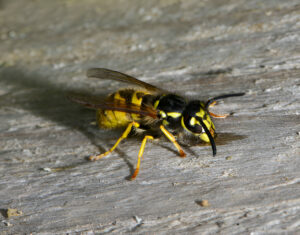
Identification
The Common Wasp, or Vespula vulgaris, is one of the most familiar wasp species in the UK. It has distinctive yellow and black stripes and measures about 12-17 mm in length. They have a characteristic black “anchor” shaped mark on the face.
Behaviour
Common Wasps are social insects that build their nests in sheltered locations such as attics, wall cavities, and underground. They are known for their aggressive behaviour when threatened and can sting multiple times.
Nesting
Their nests are made from chewed wood fibres mixed with saliva, creating a paper-like structure. These nests can house thousands of wasps and grow significantly over the summer.
German Wasp (Vespula germanica)
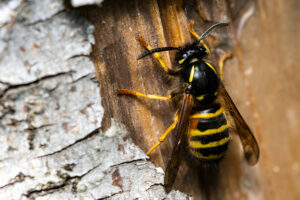
Identification
The German Wasp is similar in appearance to the Common Wasp but can be distinguished by three small black dots on the front of the face. They are also about 12-17 mm in length.
Behaviour
Like the Common Wasp, the German Wasp is social and can be aggressive, especially in late summer when their food supply diminishes, and they become more likely to sting.
Nesting
German Wasps also build paper nests, often in similar locations to Common Wasps, including eaves, attics, and bushes. Their nests can grow large, accommodating thousands of wasps.
European Hornet (Vespa crabro)
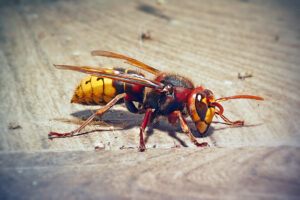
Identification
The European Hornet is the largest wasp species in the UK, measuring up to 35 mm in length. They have a reddish-brown head and thorax, with yellow and black striped abdomen.
Behaviour
European Hornets are less aggressive than Common and German Wasps but can deliver a painful sting if provoked. They are primarily active at night.
Nesting
They build their nests in hollow trees, attics, and wall cavities. The nests are made from chewed wood pulp and are usually larger and more robust than those of other wasps.
Tree Wasp (Dolichovespula sylvestris)

Identification
Tree Wasps are slightly smaller, measuring about 10-14 mm in length. They have a black and yellow striped body with a predominantly black face.
Behaviour
Tree Wasps are less aggressive than other common wasp species. They are typically found in woodland areas but can occasionally nest near homes.
Nesting
Their nests are often found hanging from trees or bushes and are smaller than those of other species, usually housing fewer wasps.
Red Mason Bee (Osmia bicornis)
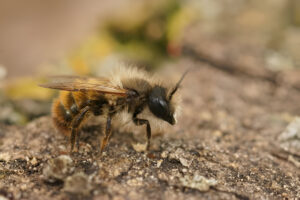
Identification
Red Mason Bees are solitary bees, about 10-12 mm in length, with a reddish-brown body and dark, dense hair. They are important pollinators and are non-aggressive.
Behaviour
These bees are solitary and do not form large colonies. Each female builds her own nest, often in existing holes in wood or masonry.
Nesting
Red Mason Bees use mud to create partitions within their nests. They lay their eggs in these mud cells, providing pollen and nectar for the larvae.
Honeybee (Apis mellifera)
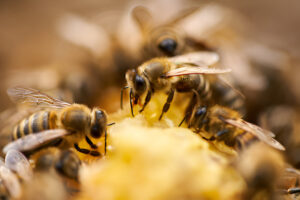
Identification
Honeybees are about 12-15 mm in length and have a golden-brown colour with darker bands. They are social insects known for producing honey and wax.
Behaviour
Honeybees are generally non-aggressive unless their hive is threatened. They are vital pollinators and live in large colonies with a single queen, workers, and drones.
Nesting
They build wax combs inside cavities like tree hollows, beehives, or wall cavities. Honeybee colonies can consist of tens of thousands of individuals.
Bumblebee (Bombus spp.)
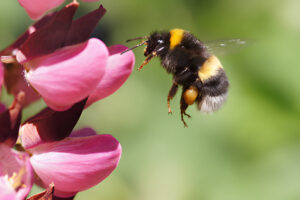
Identification
Bumblebees are larger and hairier than honeybees, with varying colour patterns of black, yellow, and sometimes orange or white.
Behaviour
Bumblebees are generally docile and only sting when threatened. They are excellent pollinators and live in smaller colonies compared to honeybees.
Nesting
Bumblebees often nest in the ground, old rodent burrows, or compost heaps. Their colonies are relatively small, usually comprising 50-400 individuals.
Mining Bees (Andrena species)
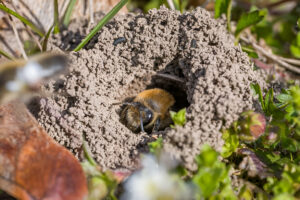
Behaviour
All solitary ground bees are generally harmless to humans and rarely sting. Males may appear more aggressive whilst searching for mates but they cannot sting.
Nesting
They dig tunnels in bare or lightly vegetated soil in lawns, flowerbeds, sandy banks or footpaths.
Conclusion
Understanding the differences between these species helps in addressing pest problems effectively and humanely. At Peskey Solutions, we are experts in identifying and safely removing wasp nests in Hertfordshire and North London. If you suspect a wasp nest on your property, contact us for a prompt and professional service. Our team is ready to ensure your home or business is safe from these unwanted visitors.
